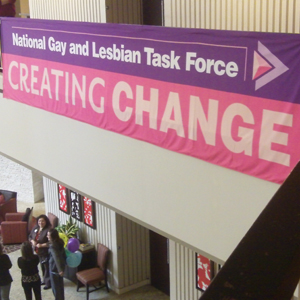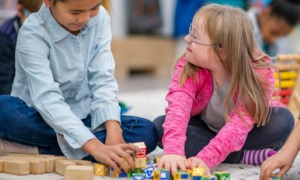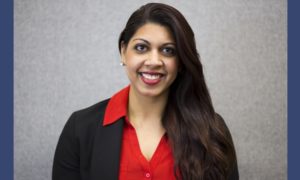 ATLANTA — Attendees at the 2013 Creating Change Conference, the 25th National Conference on LGBT Equality, were met by a message from the National Gay and Lesbian Task Force that read “Action is Hot.”
ATLANTA — Attendees at the 2013 Creating Change Conference, the 25th National Conference on LGBT Equality, were met by a message from the National Gay and Lesbian Task Force that read “Action is Hot.”
As attendees and non-attendees filtered in and out of the gargantuan hotel’s elevator — with nearby Hartsfield-Jackson Atlanta International Airport pilots brushing shoulders with neon-haired punk rockers in the lobby — the introductory message seemed to take on several different meanings for those at the event, with presenters, exhibitors and visitors tackling hard-hitting LGBT youth topics in various ways.
Shayden Gonzalez, a 28-year-old attendee from Philadelphia, is the training and facilitation director for the Safe Spaces Project, a national capacity building organization that helps other groups develop programs servicing LGBT youth.
“Our newest initiative is building an LGBT youth network, so that organizations that are doing the same work around the country can connect with each other” he said. He believes that the issues effecting LGBT young people depends on the region of the United States they live in.
“In some places, it’s housing and in some places it’s getting help with allies, other places, it’s health and wellness,” he said. “It really does depend where in the country you’re talking about.”
Lynn Young, who traveled from Walkerton, Ind. for the event, is a member of the organization Transfaith. She believes many LGBT youth in the United States face major issues regarding identity and acceptance.
“[LGBT young people] feel disenfranchised in many ways, depending on what context, where they live, and where they find themselves accepted,” Young said. “Whether it’s in families, faith communities or school communities.”
Several faith-based organizations had exhibitors and representatives at the conference. Jodi Robinson, a member of the Association of Welcoming Affirming Baptists from Pepperell, Mass., said that while many religious organizations may persecute LGBT individuals, there are numerous outfits in the country that seek to be advocates and allies for gay rights.
“A lot of people felt that by saying ‘Baptist,’ it means you’re not welcoming,” she said. “What we found out is that people within their own church or even churches within their own regions or communities, we are welcoming and affirming, but they needed to start that conversation.”
She believes that faith-based organization of the like can provide a sense of community and togetherness for LGBT young people. “When you’re young, you’re already doing questioning of your own sexuality, where you fit in, and who I am and what I am,” she said. “There should be safe havens.”
Jim Smith, an attendee from Minneapolis and a former Roman Catholic priest, is program manager for Dignity USA, an organization for LGBT Catholics and allies. He believes that, today, the greatest issue for LGBT young people is obtaining full equal rights.
“When I was a youth, it was more about owning my dignity as a kid who was gay,” he said. “Although there are certainly a lot of youth who struggle with self-acceptance and coming out, it’s less of an issue than it was when I was growing up.”
Christopher White, director of the Gay Straight Alliance (GSA) Safe and Healthy LGBT Youth Project, believes that LGBT young people should become self-advocates, and push for needs like anti-discrimination and anti-bullying policies in their own schools. “We know that when LGBTQ young people feel safer in their schools, and see representations of themselves in schools and when GSAs are present in their schools,” he said, “they feel more connected to their community and the tend to do better academically and have better health outcomes.”
Jamie Baxter is the vice president of marketing for a business called dotgay LLC, which is seeking to create a new top-level domain on the Internet. Positioned behind him is a large poster board filled with QR codes and hypothetical websites with URLs like “education.gay” and “insurance.gay.”
“I think a lot of the issues that are of a pressing nature are really around abuses and the need to get information and stamp out things like homophobia,” he said. He considers the Internet itself to be a “double-edged sword,” for LGBT young people, noting in particular the severe nature of online harassment.
“From my perspective, it seems like a harsher punishment for those who are subjected to homophobia, because it’s so much more public,” he said. “But [the Internet] has also opened a lot of doors much wider for access to information and support and services.”
Rodney Nickens, 25, is a policy and networks associate for the National Black Justice Coalition (NBJC) from Baltimore. “One of the things NBJC is committed to is building safe and inclusive schools for all youth,” he said. “Especially for black, LGBT young people.”
“Quite frankly, being LGBT is an obstacle in and of itself,” he continued. “Couple that with being African-American or a person of color, and the issues can sometimes be overwhelming and unbearable for many of our youth.”
Robin Nussbaum traveled from San Diego to attend the conference. She considers homelessness, racism and the rights of transgender individuals to be among the most important issues for LGBT youth. She has particular concerns for LGBT youth that end up in the juvenile justice system.
“[It] can be a real problem,” she said. “I always sort of call it the criminal injustice system.”
T. Aaron Hans, an attendee from Minneapolis, is concerned by the “push out” of LGBT youth in middle and high schools, which he believes frequently results in homelessness or contact with the juvenile justice system. “I think it’s a really critical issue,” Hans said. “How we see and look at bullying and harassment and discrimination in schools, and particularly, thinking about how those policies are written, so that they’re written in a way that doesn’t augment or push out any more young people.”
As with many attendees at the event, Chicora Martin, assistant dean of students and director of the University of Oregon’s LGBT Education and Support Services, believes that finding a community is one of the biggest issues facing the nation’s LGBT youth. “I think we make the assumptions that just because LGBT issues are on TV or in the news that youth are able to find people like them or find mentors or peers,” she said. “I think that’s still challenging, across the country.






























